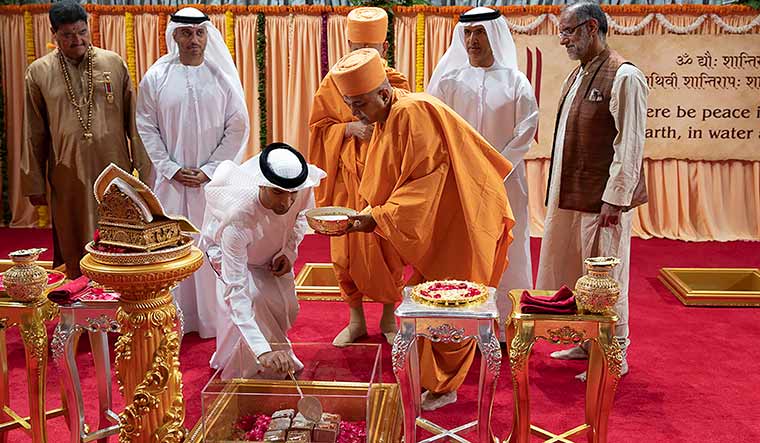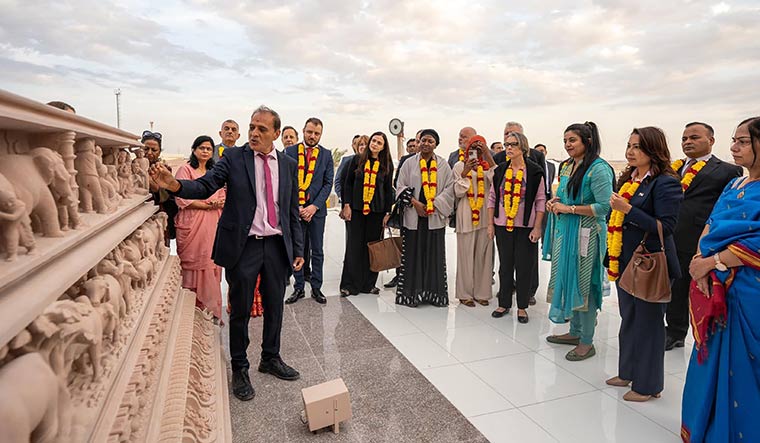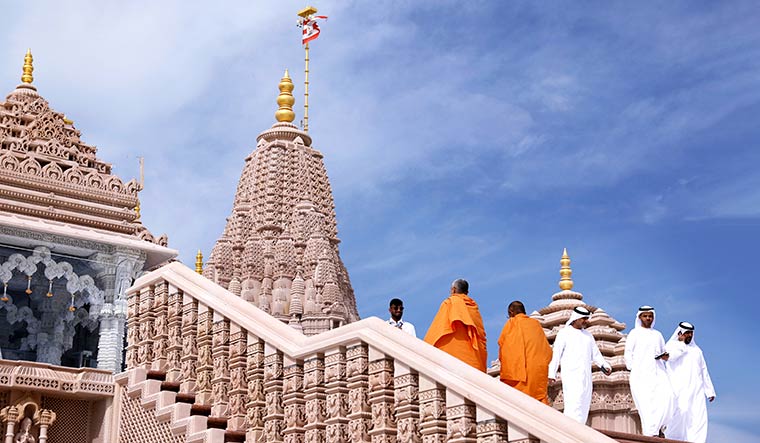Travelling across the United Arab Emirates in April 1997, Pramukh Swami of the BAPS Swaminarayan Sanstha stopped at a desert near Sharjah and sat deep in thought, under the blazing sun. People around him stood mystified. After a while, he said: “May a temple come up in Abu Dhabi. May it bring countries, cultures and religions closer together.”
Pramukh Swami was revered as the fifth spiritual successor of Bhagwan Swaminarayan and had built hundreds of temples around the globe, including the Akshardham temple in Gandhinagar. (Akshardham in Delhi would follow.) Still, his companions in the desert could not believe their ears.
“But this saint could see what nobody could,” Brahmavihari Swami, in-charge of international relations of BAPS, told me. “He was prophetic.”
In 2015 the UAE government allotted land for building a temple in Abu Dhabi free of cost. BAPS submitted two architectural designs for the temple―one traditional and the other modern. The traditional design was the preference of Abu Dhabi’s then crown prince Sheikh Mohamed bin Zayed Al Nahyan, who became president of the UAE in 2022.
Thus began the story of BAPS Hindu Mandir, the first traditional sandstone temple in the Middle East. Mahant Swami, who had succeeded Pramukh Swami [1921-2016] as BAPS president, performed the shila poojan (consecration of stone) in 2018 and the shilanyas (foundation stone laying) in 2019.
Watching the shila poojan on video link from another part of the UAE and holding a model of the temple, Prime Minister Narendra Modi thanked the crown prince for his generosity. As we went to press, the two leaders were expected at the inauguration of the temple on February 14, which would elevate India-UAE friendship to a sublime level.
 Spiritual oasis: UAE minister Thani bin Ahmed Al Zeyoudi and Brahmavihari Swami, in-charge of international relations of BAPS, lay the foundation stone for the BAPS Temple, Abu Dhabi, in 2019 | Courtesy BAPS
Spiritual oasis: UAE minister Thani bin Ahmed Al Zeyoudi and Brahmavihari Swami, in-charge of international relations of BAPS, lay the foundation stone for the BAPS Temple, Abu Dhabi, in 2019 | Courtesy BAPS
The magnificent temple stands on 27 acres at Abu Mureikhah on the outskirts of Abu Dhabi. It was still under construction when I saw it a few months ago. Hundreds of men―sculptors and workers―were polishing pillars and statues, braving the hot sun. When a sandstorm blew, they took refuge in portable shelters, but returned to work in a few minutes. “We don’t feel tired,” said Raghuveer Singh, one of the sculptors. “We feel blessed to work at the temple site.”
A number of sculptors and artisans were brought from India for the final touches. They lived in camps at the site, working closely with BAPS volunteers and municipal employees. BAPS served them free vegetarian food round-the-clock in the dining halls. All the pillars and columns had been carved in Rajasthan and then brought to Abu Dhabi. "The UAE government was so generous that it set up a dedicated corridor for us at the Dubai port for easy movement of materials," said Yogibhai Bhatt, a volunteer.
 Harmony in the desert: Mahant Swami Maharaj, spiritual leader, BAPS, being accorded a state reception in Abu Dhabi ahead of the inauguration of the temple. To his right is businessman M.A. Yusuff Ali | Courtesy BAPS
Harmony in the desert: Mahant Swami Maharaj, spiritual leader, BAPS, being accorded a state reception in Abu Dhabi ahead of the inauguration of the temple. To his right is businessman M.A. Yusuff Ali | Courtesy BAPS
The temple is open to all people, no matter their religion. “The BAPS Hindu Mandir is a spiritual oasis for global harmony,” said Pranav Desai, an Abu Dhabi resident and volunteer. “Imagine! A Muslim king donated the land; the lead architect of the complex is a Christian Catholic; the foundation designer is a Buddhist from Malaysia; the project director is a Sikh; the contractors for the outer complex are Parsis; and one of our directors is a Jain.”
The temple can hold 2,000 worshippers at any given time. Before entering it, they would tread a sand dune and then walk along a shallow pool of water brought from the confluence of the Ganga, the Yamuna and the mythical Saraswati in India. “The seven spires of the temple enshrine seven Hindu deities, while also symbolising the unity of the seven emirates,” said Brahmavihari Swami, in-charge of the temple. Growing up in the UK, he was fascinated by the monoliths of the Stonehenge in Wiltshire. The monolithic structures surrounding the BAPS Hindu Mandir, he said, would appear as if they have emerged from the desert as guardians of the temple.
 Heavenly beauty: Diplomats from 42 countries at the BAPS Hindu Mandir in Abu Dhabi | Courtesy BAPS
Heavenly beauty: Diplomats from 42 countries at the BAPS Hindu Mandir in Abu Dhabi | Courtesy BAPS
The idol of Swaminarayan, who is worshipped as an avatar of Krishna, is enshrined under the main spire. The other spires rise above the idols of Shiva, Ram, Krishna, Tirupati Balaji, Puri Jagannath and Sabarimala Ayyappa. “Where Ram and Sita are enshrined, we have the entire Ramayan carved in stone,” said Desai. “Likewise, we have carved the Mahabharat, the Shiv Purana and the story of Ayyappa. No other temple in the world has stories of so many deities told in stone in this manner.”
He pointed to sculptures on the outer walls of the temple, depicting stories of peace from ancient civilisations of India, the Middle East, Africa, China and the Aztec empire.
 Brahmavihari Swami and actor Akshay Kumar | Courtesy BAPS
Brahmavihari Swami and actor Akshay Kumar | Courtesy BAPS
The temple has been built without steel or concrete, its different parts held together by interlocking. Around 14,500 tonnes of pink sandstone and 5,500 tonnes of white marble went into the construction. “The exterior is pink sandstone from Rajasthan,” said Desai. “The interior is white marble from the south of Italy and granite. We took the stones to Rajasthani villages, and gave the artisans the design for carving. They worked on them with hammer and chisel. Most of them took almost nine months to finish one pillar.”
The temple has two parks, a community hall, a visitors’ centre, an amphitheatre, a food court and a welcome area. The visitors’ centre has an assembly hall, a library and classrooms for cultural courses and interfaith dialogue. Hundreds of trees were being planted to cool the surroundings.
 Ashok Kotecha | Anirudha Karindalam
Ashok Kotecha | Anirudha Karindalam
It was at the exhibition area outside that I met the temple chairman Ashok Kotecha. “The temple is a miracle that has emerged from the prayers of Pramukh Swami, the will of Prime Minister Modi and the generosity of the UAE rulers,” he said. “The strength to spread love, harmony and tolerance is the basic foundation of the temple.”
“This is the sweat of God,” said Kotecha, touching my sweat-drenched shirt. “It was Bhagwan Swaminarayan who brought you here to this spiritual oasis for global harmony.”
Desai also saw a divine hand behind the temple. Initially, the UAE government had allotted 2.5 acres at another place for the temple and then increased it to five acres. “BAPS never asked for any extra land,” said Desai. “Everything came to us as if it was predestined. Later, the government gave us 13.5 acres at the present location.”
Long before the shila poojan, the UAE’s Foreign Minister Abdullah bin Zayed Al Nahyan, who is the president’s brother, had visited the Akshardham temple in Delhi. After the visit, he was all the more appreciative of the temple project. Later, he inspected the new site in Abu Dhabi. He looked at the design of the temple and went to a corner. “We were worried,” said Kotecha. “He asked us where the car parking area would be. We said it would be under the temple. He told us not to do that, and sanctioned another 13.5 acres for car parking.”
Another surprise followed: BAPS engineers discovered a massive rock under the site. It was strong enough to support the entire temple structure, so there was no need for piling. “No other location in the vicinity had a such a massive rock underneath,” said Ullas Shukla, a project director. “The temple will remain stable for 1,000 years.” Shukla left a good job in Reliance to volunteer for the temple. “It seemed like a call from God,” he said. “After I became a devotee of Swaminarayan, I feel I am a lot calmer.”
There are 1,200 BAPS temples across the world, including the Akshardham temple that Mahant Swami opened last year at Robbinsville, New Jersey, in the US. It is the largest modern Hindu temple in the world. The first temple was built by Bhagwan Swaminarayan at Bochasan village in Gujarat. Hence the name BAPS ― Bochasanwasi Shri Akshar Purushottam Swaminarayan Sanstha. The deity there is called Bochansanwasi, meaning one who lives in Bochasan.
Swaminarayan was born at Chhapaiya near Ayodhya in 1781 as Ghanshyam Pande. At age 10, he accompanied his father to Varanasi and revealed his deep knowledge of the Vedas. He left home at age 11 and wandered around the country for seven years, finally settling in Loj village in Junagadh, Gujarat.
His guru Ramanand Swami initiated him as a monk in 1800 and called him Sahajanand. Sahajanand came to be known as Swaminarayan after he gave his followers the Swaminarayan mantra in 1801. He founded Ekantik dharma. By the time he died in 1830, he had 20 lakh followers and had inspired a spiritual movement called the Swaminarayan sampradaya (tradition).
There were two gadis (dioceses) within the sampradaya, one based in Vadtal and the other in Ahmedabad, and both had their offshoots. BAPS branched out of the Vadtal gadi. It was founded in 1907 by Shastriji Maharaj, the third spiritual heir to Swaminarayan.
BAPS has around 1,200 monks and 4,000 centres, including temples, and runs hospitals, schools, colleges, yoga and de-addiction centres, and blood-donation camps. It was active even during the pandemic, and it helped Indians stranded in east Europe when Russia invaded Ukraine.
BAPS monks are very well-educated, carry the latest gadgets and travel the world. But their rules forbid any contact with women; not even eye contact is allowed, let alone conversation. Usually the laity would ensure that women do not come near them at gatherings. Sometimes they deploy a cloth screen, from behind which a monk may communicate with women through a third person. There are amusing ways of dealing with female flight attendants who ask them what they would like to eat or drink. If travelling alone, a monk would look away while answering.
If two monks are travelling together, they would look at each other while doing so.
J.M. Dave, 81, is the director of BAPS Swaminarayan Research Institute in Delhi, which holds inspirational talks for civil service aspirants and PhD scholars. Dave has seen four spiritual heads of BAPS during his lifetime. “My youngest brother became a monk at 19,” he said. “Today, he is 69 and is the mahant at the Akshardham temple in Gandhinagar.” So, what do the brothers do when they meet? “In the BAPS tradition, once you become a monk you cannot talk to your family members,” he said. “Even if I meet him by chance, we greet each other with a ‘namaste’ and don’t start a conversation.”
Detachment is part of their monastic rigour. “It is not as if we were forced into it,” said Swami Aksharatit Sadhu, 39, who was born in Africa but grew up in Chicago. “When we become sadhus, permission is taken from our parents. Only if they agree in writing do we follow this path.”
Also Read
- Karyakar Suvarna Mahotsav: PM Modi says institutional service can solve big problems of society
- No T-shirts or tight-fitting clothes: Check dress code for UAE’s first Hindu stone temple
- Get immense support from UAE government, says Lulu Group CEO
- Indians open up to THE WEEK on their connect with UAE
- 'BAPS Hindu Mandir is a story of hearts and minds': Mahant Swami Maharaj
- 'We do not build temples to show off': Brahmavihari Swami
Like him, many followers of Swaminarayan have African connections. A large number of Indians, especially from Gujarat and Rajasthan, migrated to Africa in the last century. Many of them spread the teachings of Swaminarayan. The first Swaminarayan temple outside the Indian subcontinent was built in Nairobi in 1945. And most of their temples are in Africa.
There were two lakh Indians in Africa in the 1960s. Half of them were Swaminarayan people. They had flourished, especially as traders. But as they grew, so did an anti-India sentiment in Uganda, and president Idi Amin expelled 80,000 Indians in 1972. More than 25,000 of them found refuge in the UK alone.
“The expulsion was a blessing in disguise. Otherwise we would not have moved to England,” said Sagoon Bhai, a project manager, who had migrated with his family. “I met Pramukh Swamiji as a young man in the UK. His sincerity, humility and focus inspired me.” Ten years ago, David Cameron, as prime minister of the UK, said Indians from Uganda were “one of the most successful groups of immigrants anywhere in the history of the world.”
The Uganda saga had a happy ending. In 1997, President Yoweri Museveni returned to BAPS four temples Idi Amin had taken over. He appealed to the Indians to return and help rebuild Uganda.
A number of diplomats and ministers from various countries have already visited the temple in Abu Dhabi. So did actors Akshay Kumar and Sanjay Dutt. "This project was scripted in heaven and is now being played here on earth," Brahmavihari Swami told Akshay Kumar. “This is a dream of dreams,” the actor replied.


